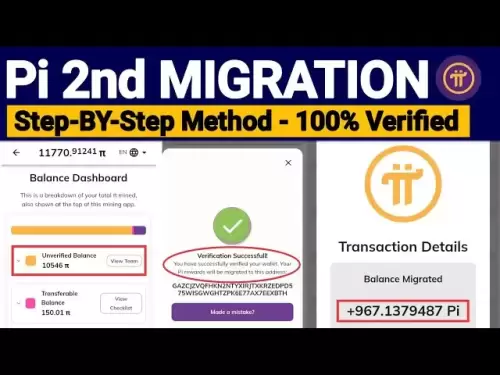-
 Bitcoin
Bitcoin $117,991.5647
-0.03% -
 Ethereum
Ethereum $2,966.4808
0.18% -
 XRP
XRP $2.8076
0.64% -
 Tether USDt
Tether USDt $1.0003
0.00% -
 BNB
BNB $689.9050
-0.63% -
 Solana
Solana $162.0407
-0.80% -
 USDC
USDC $0.9999
0.00% -
 Dogecoin
Dogecoin $0.1995
-1.51% -
 TRON
TRON $0.3001
-1.21% -
 Cardano
Cardano $0.7426
3.25% -
 Hyperliquid
Hyperliquid $47.7978
2.84% -
 Stellar
Stellar $0.4411
16.52% -
 Sui
Sui $3.4267
0.15% -
 Chainlink
Chainlink $15.3148
0.07% -
 Bitcoin Cash
Bitcoin Cash $506.5880
-1.91% -
 Hedera
Hedera $0.2222
12.41% -
 Avalanche
Avalanche $21.2049
1.67% -
 UNUS SED LEO
UNUS SED LEO $9.0606
-0.19% -
 Shiba Inu
Shiba Inu $0.0...01325
-0.86% -
 Toncoin
Toncoin $2.9979
0.32% -
 Litecoin
Litecoin $94.3717
1.13% -
 Polkadot
Polkadot $3.9873
-0.29% -
 Monero
Monero $336.1497
0.92% -
 Dai
Dai $0.9999
-0.01% -
 Uniswap
Uniswap $8.5189
-0.60% -
 Ethena USDe
Ethena USDe $1.0005
-0.04% -
 Pepe
Pepe $0.0...01236
-0.92% -
 Bitget Token
Bitget Token $4.4002
-0.23% -
 Aave
Aave $303.5433
1.05% -
 Bittensor
Bittensor $391.1314
-0.35%
Best ASIC miner for beginners
An ASIC miner is a specialized device designed for cryptocurrency mining, offering high efficiency and performance for specific hashing algorithms like SHA-256 or Scrypt.
Jul 13, 2025 at 11:08 am

What is an ASIC Miner?
An ASIC miner is a specialized piece of hardware designed specifically for mining cryptocurrencies. ASIC stands for Application-Specific Integrated Circuit, and these devices are optimized to perform the hashing algorithms required for blockchain networks like Bitcoin. Unlike general-purpose hardware such as CPUs or GPUs, ASIC miners are not suitable for other computing tasks but offer significantly higher efficiency and performance when mining specific cryptocurrencies.
For beginners, it’s important to understand that not all ASIC miners are the same. Different models are built for different hashing algorithms, such as SHA-256 for Bitcoin or Scrypt for Litecoin. Choosing the right one depends on your mining goals, budget, and electricity costs. The efficiency of the miner, measured in joules per terahash (J/TH), plays a crucial role in determining profitability.
Key Factors to Consider When Choosing an ASIC Miner
When selecting the best ASIC miner for beginners, several factors must be taken into account to ensure a smooth and potentially profitable experience:
- Hashrate: This refers to the computing power of the miner and is usually measured in TH/s (terahashes per second) for SHA-256 miners. A higher hashrate generally means more potential earnings.
- Power Consumption: Miners consume a significant amount of electricity, so it’s vital to understand how much power your chosen miner uses. This is typically listed in watts (W).
- Cost: The initial investment can vary widely between models. Beginners should look for a balance between price and performance.
- Noise and Heat: ASIC miners can be noisy and generate a lot of heat, so consider where you’ll place the miner and how to manage ventilation.
- Manufacturer Reputation: Stick with well-known brands like Bitmain, MicroBT, or Canaan to ensure reliability and after-sales support.
Each of these elements plays a role in determining whether your mining venture will be profitable or not. Beginners should not overlook electricity costs, as they can quickly eat into potential profits.
Top ASIC Miners for Beginners
Several ASIC miners are particularly well-suited for beginners due to their user-friendly setup, reasonable efficiency, and availability. Here are some of the best options:
- Bitmain Antminer S19j Pro (100 TH/s): This model offers a good balance of hashrate and efficiency, making it ideal for beginners who want a reliable miner with moderate power consumption.
- MicroBT WhatsMiner M30S++ (112 TH/s): Known for its strong performance, this miner is slightly more advanced but still manageable for newcomers.
- Canaan AvalonMiner 1246 (90 TH/s): This miner is known for its sturdiness and long-term reliability, making it a good option for beginners who want a durable machine.
- Bitmain Antminer T19 (84 TH/s): A slightly less powerful but more affordable option, ideal for those with a limited budget.
Each of these miners has its own pros and cons, and beginners should compare them based on hashrate, power efficiency, and cost before making a purchase.
How to Set Up an ASIC Miner
Setting up an ASIC miner might seem daunting at first, but the process is relatively straightforward if you follow the correct steps:
- Connect the miner to a power source: Most ASIC miners require a dedicated power supply unit (PSU). Ensure your PSU is compatible with the miner’s voltage and amperage requirements.
- Connect the miner to your network: Use an Ethernet cable to connect the miner directly to your router. Wi-Fi is not recommended due to potential latency issues.
- Access the miner’s web interface: Open a browser and enter the miner’s IP address to access its configuration panel. You can find the IP address by checking your router’s connected devices list.
- Configure mining settings: Enter your mining pool address, username, and password. These details are provided by your chosen mining pool.
- Monitor performance: Use the built-in dashboard or third-party tools to monitor temperature, hashrate, and power consumption.
Make sure to keep your miner in a well-ventilated area to avoid overheating. Some miners come with built-in cooling systems, but external fans can help improve airflow.
Choosing a Mining Pool and Wallet
Mining solo is generally not recommended for beginners due to the high variance in block rewards. Instead, joining a mining pool allows you to combine your hashrate with others and earn more consistent payouts.
When choosing a mining pool, consider the following:
- Pool fees: Most pools charge a small percentage of your earnings, so compare fee structures before joining.
- Payout methods: Look for pools that offer PPLNS (Pay Per Last N Shares) or PPS (Pay Per Share) payout schemes.
- Server locations: Choose a pool with servers close to your geographic location to reduce latency.
In addition to a mining pool, you’ll need a cryptocurrency wallet to store your earnings. Use a non-custodial wallet like Electrum for Bitcoin or Litecoin Core for Litecoin. Make sure to back up your recovery phrase securely and avoid using exchange wallets for long-term storage.
Frequently Asked Questions
Q: Can I use an ASIC miner for Ethereum?
A: No, most ASIC miners are designed for SHA-256 or Scrypt algorithms, while Ethereum uses the Ethash algorithm, which is resistant to ASIC mining.
Q: Do I need a special power supply for an ASIC miner?
A: Yes, most ASIC miners require a dedicated PSU that can handle high wattage. Check the manufacturer’s specifications to ensure compatibility.
Q: Is it profitable to mine with an ASIC miner as a beginner?
A: Profitability depends on electricity costs, cryptocurrency prices, and mining difficulty. Use online calculators to estimate potential earnings before investing.
Q: How long do ASIC miners last?
A: With proper care, ASIC miners can last 2 to 5 years, though performance may decline over time due to wear and increasing difficulty.
Disclaimer:info@kdj.com
The information provided is not trading advice. kdj.com does not assume any responsibility for any investments made based on the information provided in this article. Cryptocurrencies are highly volatile and it is highly recommended that you invest with caution after thorough research!
If you believe that the content used on this website infringes your copyright, please contact us immediately (info@kdj.com) and we will delete it promptly.
- Crypto, Gold, and Bitcoin: A New York Minute on the Digital Gold Rush
- 2025-07-13 20:30:16
- Crypto iGaming in India: JetTon, LunarBet, and the Evolving Landscape
- 2025-07-13 20:50:16
- XRP Price, Whales, and Payment Tokens: A New Era for Crypto?
- 2025-07-13 20:35:16
- Shiba Inu, Little Pepe, and the $1 Dream: A Meme Coin Showdown
- 2025-07-13 20:50:17
- Snorter Trading Bot: The Meme Coin Presale That's More Than Just Hype
- 2025-07-13 18:30:16
- Unlocking Blockchain Insights: A Deep Dive with Bitquery API for Data Query
- 2025-07-13 18:30:16
Related knowledge

How to keep a mining rig cool
Jul 12,2025 at 01:42pm
Understanding the Importance of Cooling in Mining RigsCryptocurrency mining is an intensive process that places heavy demand on hardware components, p...

How much does it cost to start crypto mining?
Jul 13,2025 at 12:22am
Understanding the Basic Costs of Crypto MiningStarting crypto mining involves several upfront and ongoing expenses. The primary costs include hardware...

What is the most profitable crypto to mine?
Jul 13,2025 at 07:00am
Understanding Mining Profitability in CryptocurrencyWhen evaluating the most profitable crypto to mine, it's essential to consider several factors tha...

What do I need to start mining crypto?
Jul 13,2025 at 12:28am
Understanding the Basics of Crypto MiningCrypto mining is the process by which transactions are verified and added to a blockchain, and new coins are ...

How does crypto mining work?
Jul 13,2025 at 11:01am
Understanding the Basics of Crypto MiningCrypto mining is the process through which new cryptocurrency coins are introduced into circulation and trans...

How to find the best Dogecoin mining pool for me
Jul 12,2025 at 04:14pm
Understanding the Role of a Mining PoolWhen mining Dogecoin, joining a mining pool can significantly increase your chances of earning consistent rewar...

How to keep a mining rig cool
Jul 12,2025 at 01:42pm
Understanding the Importance of Cooling in Mining RigsCryptocurrency mining is an intensive process that places heavy demand on hardware components, p...

How much does it cost to start crypto mining?
Jul 13,2025 at 12:22am
Understanding the Basic Costs of Crypto MiningStarting crypto mining involves several upfront and ongoing expenses. The primary costs include hardware...

What is the most profitable crypto to mine?
Jul 13,2025 at 07:00am
Understanding Mining Profitability in CryptocurrencyWhen evaluating the most profitable crypto to mine, it's essential to consider several factors tha...

What do I need to start mining crypto?
Jul 13,2025 at 12:28am
Understanding the Basics of Crypto MiningCrypto mining is the process by which transactions are verified and added to a blockchain, and new coins are ...

How does crypto mining work?
Jul 13,2025 at 11:01am
Understanding the Basics of Crypto MiningCrypto mining is the process through which new cryptocurrency coins are introduced into circulation and trans...

How to find the best Dogecoin mining pool for me
Jul 12,2025 at 04:14pm
Understanding the Role of a Mining PoolWhen mining Dogecoin, joining a mining pool can significantly increase your chances of earning consistent rewar...
See all articles

























































































